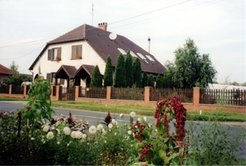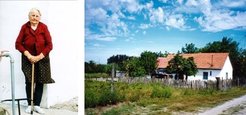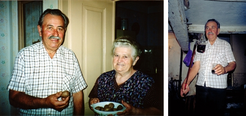Comparisons - Central European Villages Repeatedly Visited
The most basic change is that the cooperative is no longer active in agricultural production and all land has been returned to private ownership. The main results of my most recent fieldwork (2001) are reflected in Working Paper 26. They are also discussed elsewhere on this website: Current Research Project.
Many people believe that social inequalities have widened considerably, both between the countryside and the town, and within the village itself. They say that people no longer help each other, notably with housebuilding, nor do they get together for social purposes as they used to in the past (when a Dramatics Society organized by a teacher brought many people of very different backgrounds together on a regular basis).
Housing extremes in the upper hamlet

This house was built in the 1990s by a newcomer to the community who produces flowers for the national market; he declined to be inter- viewed or photographed.

This lady lives alone in the house on the right, which she inherited from her husband. With no kind in the region, she is dependent on the local social services.

István Gulyás demonstrating the quality of his potatoes (left, with wife) and (right) his red wine in his cellar. After pushing hard in the early 1990s to regain his previous ownership rights, he has since been obliged by increasing age to dispose of most of his land.
Postsocialism brought many old people the satisfaction of becoming owners of their patrimony once again. However, many of these people, such as the couple pictured left, were now too old to work this land, so the freshly acquired land was either sold or simply left uncultivated. With the cooperative withdrawing from agricultural production entirely, the total agricultural output of the community has fallen sharply. Villagers are bitter about the uncertainty in marketing, which contrasts with the stability they took for granted under socialism.

József Lázár is mildly handicapped and did not complete his basic education. In 2001 as in 1976 I found him living alone on a tanya, under the watchful eye of relatives but also supported with meals by the village council.



